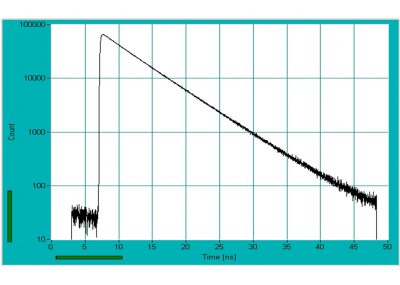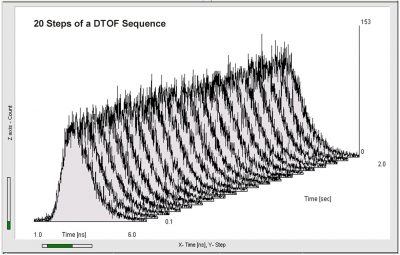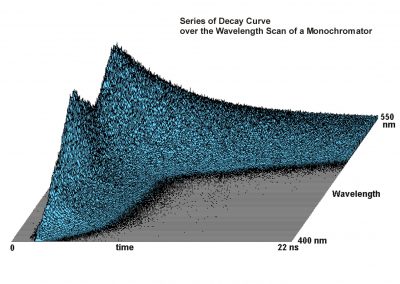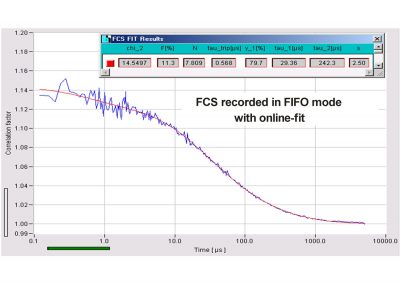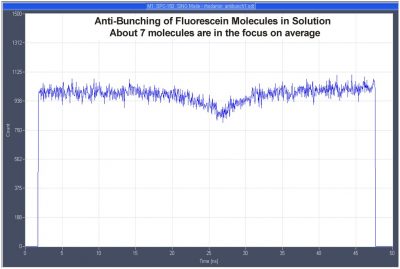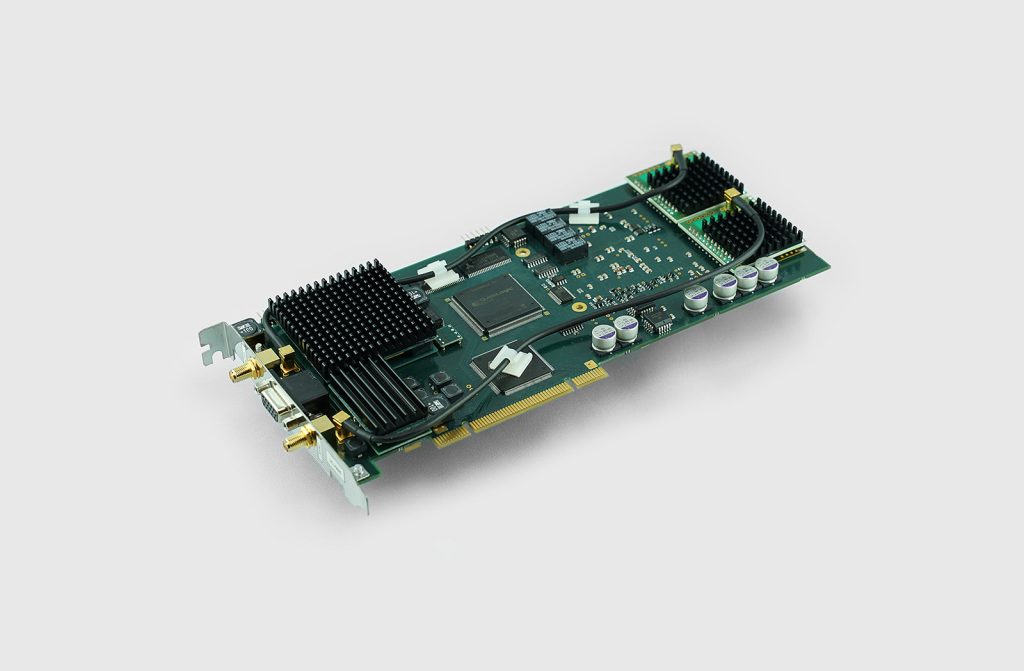
- Time Channel Width Down to 203 fs
- Electrical Time Resolution Down to 1.1 ps RMS (<3 ps FWHM)
- 10 MHz Saturated Count Rate
- Fluorescence Decay Recording
- Phosphorescence Decay Recording
- Photon Correlation
- Single-Molecule Spectroscopy
- Free Instrument Software for Windows 10 / 11 (Realtime Calculation and Fitting of FCS Curves)
- Parallel Operation of Up to 4 Modules
- Available as Multi-Module Package e.g. SPC-132-EMN, SPC-133-EMN and SPC-134-EMN
Description
The SPC-130-EMN is a small size and low-cost time-correlated single photon counting (TCSPC) module (patented) with high-time resolution for standard fluorescence lifetime applications and for applications requiring a large number of parallel TCSPC channels. The board offers a PCI interface and can be easily installed in nearly all PCs.
General Information
The SPC-130-EMN boards have all standard photon distribution modes, the continuous-flow mode, and the FIFO (time-tag) mode implemented. However, this board has no imaging mode. The SPC-130-EMN board can thus be used for traditional fluorescence lifetime experiments, diffuse optical tomography, stopped flow experiments, single molecule detection and combined FCS/lifetime experiments. The SPC-130-EMN has especially overvoltage-hardened signal inputs. They are reliable and rugged, and can be used even under harsh conditions. When ordered in large quantities for OEM applications, the bh SPC-130-EMN modules offer unprecedented price-performance ratio. The module is upgradable to SPC-150N for fluorescence lifetime imaging microscopy (FLIM) and other laser scanning applications.
Measurement Software Included
The SPCM operating and measurement software is included with all SPC series modules. SPCM provides online calculation and display (2D, 3D) of data (decay curves, FCS and FCCS) acquired in multiple operation modes. SPCM software undergoes active continuous development. SPCM receives frequent updates with new features and bug fixes. Read more…
FLIM and FCS Data Analysis
For advanced fluorescence lifetime single-curve data analysis, please use SPCImage.
For advanced fluorescence correlation spectroscopy (FCS) and cross-correlation (FCCS) data analysis, please use Burst Analyzer.
Custom Programming Libraries (DLL, LabVIEW)
For automation and custom software integration, DLLs and LabVIEW drivers are available. Read more…
Specifications
|
|
SPC-130-EMN |
SPC-130-EMNX |
SPC-130-EMNXX |
|||
|
Photon Channel |
|
|||||
|
Principle |
Constant Fraction Discriminator (CFD) |
|||||
|
Discriminator Input Bandwidth |
4 GHz |
|||||
|
Time Resolution (FWHM/RMS, electr.) |
< 6.6 ps / 2.5 ps |
< 3.5 ps / 1.6 ps |
< 3 ps / 1.1 ps |
|||
|
Variance in Time of IRF max. |
< 1 ps over 50 s |
|||||
|
Optimum Input Voltage Range |
-30 mV to -500 mV |
|||||
|
Min. Input Pulse Width |
200 ps |
|||||
|
Threshold |
0 to -250 mV |
|||||
|
Zero Cross Adjust |
-100 mV to 100 mV |
|||||
|
Syncronisation Channel |
|
|||||
|
Principle |
Constant Fraction Discriminator (CFD) |
|||||
|
Discriminator Input Bandwidth |
4 GHz |
|||||
|
Optimum Input Voltage Range |
-30 mV to -500 mV |
|||||
|
Min. Input Pulse Width |
200 ps |
|||||
|
Threshold |
0 to -250 mV |
|||||
|
Frequency Range |
0 to 150 MHz |
|||||
|
Frequency Divider |
1, 2, 4 |
|||||
|
Zero Cross Adjust |
-100 mV to 100 mV |
|||||
|
Time-to-Amplitude Converters / ADCs |
|
|||||
|
Principle |
Ramp Generator / Biased Amplifier |
|||||
|
TAC Range |
50 ns to 5 µs |
25 ns to 2.5 µs |
12.5 ns, 25 ns, 50 ns |
|||
|
Biased Amplifier Gain |
1 to 15 |
|||||
|
Biased AmplifierOffset |
0 % to 50 % of TAC Range |
|||||
|
Time Range incl. Biased Amplifier |
3.3 ns to 5 µs |
1.67 ns to 2.5 µs |
0.834 ns to 50 ns |
|||
|
Min. Time Channel Width |
813 fs |
405 fs |
203 fs |
|||
|
ADC Principle |
Flash ADC with Error Correction |
|||||
|
Diff. Nonlinerarity |
< 0.5 % RMS, typ. < 1 % peak-peak |
|||||
|
Data Acquisition |
Histogram Mode |
|||||
|
Method |
on-board 2-dim. histogramming process |
|||||
|
Online Display |
Decay curves (waveforms) |
|||||
|
Dead Time |
100 ns, independent of computer speed |
|||||
|
Saturated Count Rate |
10 MHz |
|||||
|
Sustained Count Rate |
10 MHz |
|||||
|
Max. useful Count Rate (50 % loss) |
5 MHz |
|||||
|
Max. Number of curves in memory |
65536 |
16384 |
4096 |
1024 |
256 |
64 |
|
Number of Time Channels / Curve |
4 |
16 |
64 |
256 |
1024 |
4096 |
|
Max. Counts / Channel |
16 bits |
|||||
|
Overflow Control |
none, stop, repeat and correct |
|||||
|
Collection Time |
0.1 µs to 100,000 s |
|||||
|
Diplay Interval Time |
0.1 µs to 100,000 s |
|||||
|
Repeat Time |
0.1 µs to 100,000 s |
|||||
|
Curve Control (Internal Sequencing) |
Programmable Hardware Sequencer |
|||||
|
Input Curve Control (Routing) |
4 bit, TTL |
|||||
|
Input Count Enable Control |
1 bit, TTL |
|||||
|
Input External Event Markers |
4 bit, TTL |
|||||
|
Input Experiment Trigger |
TTL |
|||||
|
Data Acquisition |
FIFO / Parameter-Tag Mode |
|||||
|
Method |
Time and wavelength tagging of individual photons and continuous writing to disk |
|||||
|
Online Display |
Decay functions, FCS, Cross-FCS, PCH MCS Traces |
|||||
|
FCS Calculation |
Multi-tau algorithm, online calculation and online fit |
|||||
|
Number of counts of decay/ waveform recording |
unlimited |
|||||
|
Dead Time |
100 ns |
|||||
|
Saturated Count Rate, Peak |
10 MHz |
|||||
|
Sustained Count Rate (bus transfer limit) |
typ. 4 MHz |
|||||
|
Output Data Format (ADC / Macrotime / Routing) |
12 / 12 / 4 |
|||||
|
FIFO Buffer Capacity (Photons) |
2 * 106 |
|||||
|
Macro Timer Resolution, Internal Clock |
25 ns, 12 bit, overflows marked by MOTF entry in data stream |
|||||
|
Input Macro Timer Resolution, Clock from Sync |
10 ns to 100 ns, 12 bit, overflow marked by MOTF entry in data stream |
|||||
|
Input Curve Control (external Routing) |
4 bit, TTL |
|||||
|
Input Count Enable Control |
1 bit, TTL |
|||||
|
Input Experiment Trigger |
TTL |
|||||
|
Operation Environment |
|
|||||
|
PC System |
Windows 8 / 10, > 8 GB RAM, 64 bit operating system recommended |
|||||
|
PC Interface |
PCI |
|||||
|
Power Consumption |
approx. 12 W from +5 V, 0.7 W from +12 V |
|||||
|
Dimensions |
240 mm x 130 mm x 15 mm |
|||||


